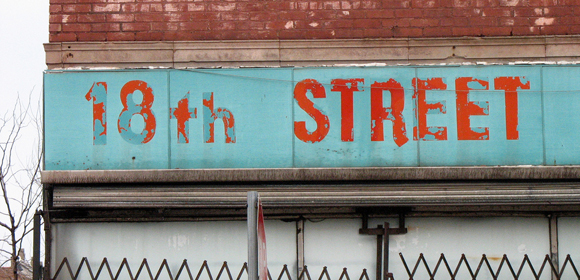
Interview with a Gentrifier
Return to page 2 | Page 3 of 4
Longing for a sense of community: Reflexivity
Anywhere in the city I was living, probably because I’m from the suburbs, I would feel in some ways like an outsider. And maybe [it’s also] because of my somewhat privileged position of being able to choose, without much restraint on which neighborhood I live in. (Fred, interview, April 4, 2008)
Everyone I spoke to acknowledged that Pilsen has been undergoing change in the past few years. The 2004 Lonely Planet City Guide: Chicago comments that while the “hipster underground” has been relocating here for years, “artists and the Latino residents are becoming nervous about the future of their neighborhood.”
One interesting theme was that the type of gentrification happening in Pilsen might be different from the “bad” kind, such as the institutionalized and rapid transformation seen in University Village [on the near west side, formerly the Maxwell Street area] during the 1990s. “You don’t see tear-downs and condos being built up, like you see everywhere on the North Side,” said Fred. Neighborhoods like Logan Square or Pilsen, Cassie argued, are becoming gentrified in a very specific way, “by artists and hipsters and people who’re into this ‘scene.’” However, theories of gentrification all argue that it is this first wave of “artists and hipsters” that pave the way for later redevelopment.
Observations like these do raise the uncomfortable question of whether it is just a matter of time before the neighborhood begins to undergo more significant changes. Cassie, who was abroad during the months of December and January, described being incredibly surprised upon her return to see what had changed in the short time that she’d been away. “I can’t stress enough how much just living here for eight months I have noticed gentrification happening,” she said. “We can see condos going up around us. And I’m not talking gentrification of, you know, young…artistic scenesters—I’m talking about people building condos for rich people.”
 After her roommate was attacked, Cassie admitted that they wondered whether it was an act of aggression against the gentrifying class in general. Michelle described feeling uncomfortable when, a year or two ago, stickers began popping up all over Pilsen that said, “Keep the gringos out!” More explicit than the anti-yuppie graffiti Tony had encountered, these overt statements of hostility made her feel both “weird” and “annoyed.” “From the individual perspective,” she complained, “It’s like, why can’t…you shouldn’t judge me! Because you don’t know [me.]” Tony argued that “the point that is missed” by anti-gentrification activists is that taking it as “their moral responsibility to keep these neighborhoods as they are” is also an implicit endorsement of continued residential segregation.
After her roommate was attacked, Cassie admitted that they wondered whether it was an act of aggression against the gentrifying class in general. Michelle described feeling uncomfortable when, a year or two ago, stickers began popping up all over Pilsen that said, “Keep the gringos out!” More explicit than the anti-yuppie graffiti Tony had encountered, these overt statements of hostility made her feel both “weird” and “annoyed.” “From the individual perspective,” she complained, “It’s like, why can’t…you shouldn’t judge me! Because you don’t know [me.]” Tony argued that “the point that is missed” by anti-gentrification activists is that taking it as “their moral responsibility to keep these neighborhoods as they are” is also an implicit endorsement of continued residential segregation.
Michelle and others resented being seen as “gentrifiers” rather than individuals who had rational choices for wanting to move to Pilsen. There is a “discomfort, and that uncertainty, should I feel bad about living there?” she asked. When discussing his own living situation, Sid said, “Even though it is gentrifying, and we are the face of gentrification—you go because you want to feel some kind of authentic Chicago experience,” drawing a contrast between this desire and “the talk of stereotypical gentrifiers,” which he characterized as a sort of ethnic fetishism, “this sort of like, ‘Oh, I love the local flavor!’” This tension between recognizing one’s own role in perpetuating neighborhood change and having to weigh it against the search for authenticity in the face of alienation is one that is difficult to overcome.
“Stereotypical gentrifiers” are characterized as people who are invading the neighborhood, passively consuming the local culture rather than integrating—or trying to integrate—into it. The people I interviewed did not identify as “stereotypical gentrifiers.” Much like the way in which I observed my interview subjects’ identities being formed in opposition to the yuppie or the suburbanite, who are perceived as consumers unconcerned with questions of authenticity or personal connection, the opposition I observed to the idea of the “stereotypical gentrifier” hinged on an aversion to this notion of passive spectatorship or consumption.
Conclusions
Throughout the research process, I was worried that I would come to the inevitable conclusions that I had seen made so many times in the literature: that middle-class gentrifiers glamorize poverty, that they were “slumming it,” or that they were engaging in a kind of invasive cultural tourism.
But once I sat down with the data, an interesting new story emerged. For the individuals I interviewed, the appeal of gentrifying areas was not superficial, but rather based in a deep-seated desire for authenticity in the face of urban alienation, and the decision to move to a gentrifying neighborhood was not undertaken lightly.
As Charles Taylor has observed, modernity does not come without its costs. “People speak of a loss of resonance, depth, or richness in our human surroundings; both in the things we use and in the ties which bind us to others,” he says (501). “In a world of changing affiliations and relationships, the loss of substance, the increasing thinness of ties and shallowness of the things we use, increases apace” (508). Gentrification can therefore be read as this: a choice ultimately rooted in the desire to reject the alienation of mass consumer culture and spaces in favor of the opportunity to forge personal connections with a wider community.
To request a copy of Chicago Studies, please contact the Core.
